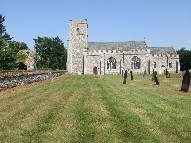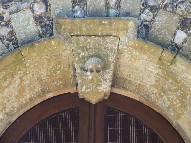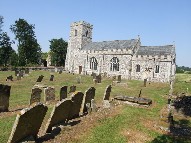| |
|
All
Saints, West Acre
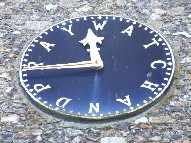 |
|
As
Simon Jenkins famously observed, the parish
churches of England constitute the world's
largest folk museum. Some parishes are not
entirely comfortable with this, prefering to be
seen as spiritual touchstones and Houses of God,
which is certainly true of many of them. In any
case, the two things are not mutually exclusive.
Still other parishes keep their churches locked
from one end of the week to the other, preserving
them as the splendid, subsidised venues of the
Sunday club - but the less said about them the
better. West Acre, I will say immediately, does
not fit into this final category, and while it
may not be as famous as its neighbours, the grand
Castle Acre and the beautiful South Acre, and
while it is certainly a spiritual touchstone,
here is a church that tells us more than most
churches do about the life of its parish down the
long generations; a a folk museum indeed. |
Although
we are barely a mile from the middle of touristy Castle
Acre, the lanes and fields here feel particularly remote.
At one time, there was a priory here, and the gateway
sits immediately to the west of the church. The church
itself is rather striking, because it was substantially
rebuilt in the early years of the 17th century, an
unusual date. The style is essentially Perpendicular, but
this is very late Gothic Survival rather than very early
Gothic Revival. The north side of the building, with its
large porch and vestry transept, sprawls comfortably like
a sleeping lion. The south side is rather starker, and
the long wall abutting the tower a curiosity. The
rebuilding was at the behest of Sir Edward Barkham, whose
fantastic tomb we have already come across at South Acre.
His death head symbol is placed above the entrance to the
porch, which contains a 13th century relief sculpture
which must have come from the priory originally. The
clock on the tower exhorts us to Watch and Pray.
You step
into a well-kept, largely restored interior, with a feel
of the late 19th and early 20th centuries about it. On
the west wall are several WWI memorials, including a
quaint roll of honour, and there are several other
memorials to WWI deaths around the church - this parish
appears to have lost a disproportionately high number of
its young men. The church has also an unusually large
number of 18th and 19th century memorials. Many of these
are to the Hamond family. Their brass plaques from
several generations line the north wall of the sanctuary,
and construct a fascinating picture of a single family
over the course of the 19th century. The best thing of
all is that you cannot only read about them, you can
actually see some of them, because the east window which
remembers them features images of four of them along the
bottom. From the left, they are Richard Anthony Hamond,
Curate of St Paul's Bethnal Green, who died on the 24th
of October 1894, aged 26; Lewis Hamond, who was born on
the 15th October 1860, and died at Pincher Creek, Canada,
on 14th February 1900, aged 39; Robert Nicholas Hamond,
Commander, Royal Navy, who was born on the 15th of May,
1844, and died on the 11th May 1894, aged 49; and the
father of the first three, Philip Hamond, who kneels with
the High Priest Melchizidek.
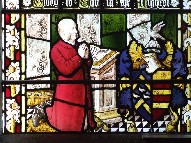 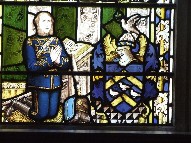 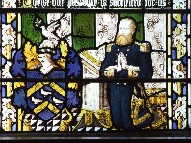 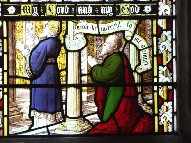
Aside from
being of great interest, this window is excellent. It is
by Burlison and Grys, and was installed in 1907. It
features a central Annunciation flanked by St Thomas and
St Matthew, with scenes from the life of Christ. The
highlight of the church, in my opinion.
| Elsewhere
are memorials to the Hamond, Birkbeck, and other
families, including some real curiosities. Thomas
Fryer's plaque portrays the flags of Australia
and New Zealand. Like many north-west Norfolkers,
he was killed at Gallipolli, but in his case this
was as a member of a New Zealand regiment, the
4th Auckland Mounted Rifles. Jacob E Brown also Passed
from Death unto Life in 1915, but at the age
of 63; he was the village schoolmaster. Six years
earlier, Gillian Mary Birkbeck died the furthest
from home of all. She was a missionary in Japan,
and was killed in the city of Kobe, after just
one year of work. Overlooking all of them is the
magnificent angel on an earlier Hamond memorial;
serene and superior, she points skywards, as if
to tell us where all the Hamonds, the Birkbecks,
and all the other families of West Acre have
gone. |
|
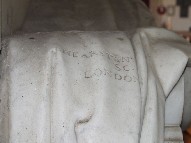 |
|
|
|

